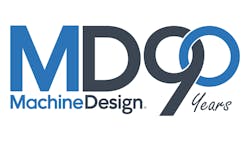As part of Machine Design’s 90th anniversary issue in January, we’ve asked industry experts to take a look at the present and future of technology and how it will impact the design and operation of manufacturing over the next decade.
Q: How is 3D printing addressing the challenges design engineers face?
Benning: 3D printing is pioneering a new wave of design capabilities for design engineers who can now create durable prototypes and end-use production parts.
3D is about more than simply competing for cost and speed optimizations of the same product. The true potential of 3D is realized when engineers can develop products which cannot be manufactured today. The seamlessness of the interface between design tools and 3D printers becomes even more important as our future printers enable multiple properties within one object, enabling changing colors, textures, transparency, strength, elasticity, conductivity, and more.
For design engineers, 3D printing empowers engineers to take their ideas and turn them into tangible prototypes or fully functional final parts. With HP’s Multi Jet Fusion technology, design engineers can create unique designs and build complex parts easily, without limitations.
Benning: 3D printing allows for rapid prototyping, elevating initial ideas with low-risk concept explorations that look like real products. This eliminates the problem that design engineers have where they have a new idea or product but are unable to turn it into a tangible part for testing or to determine where modifications need to be made to the design.
Another issue for design engineers previously was fully understanding how to translate rapid prototyping into full-scale production of final parts. Technology enables design engineers to go from prototyping to production on one platform, providing them with the confidence that successful testing of initial ideas can seamlessly carry over to mass production.
The ability to improve the freedom of design is one advantage of 3D printing, but it also enables designers to customize designs. As 3D printing is well-suited for one-off productions and building single parts in one process, it means that the ability to customize is there to take advantage of. With 3D printing, unique geometric designs can be made and printed even today.
Q: How do you see the future? How will products/solution evolve?
Benning: I’m going to frame the future through the lens of the auto industry. Carmakers are seeing a shift away from the internal combustion engine toward electric vehicles (EVs), and so 3D printing represents a huge opportunity. As they create new production lines for EVs, automakers will start to re-evaluate the way they design and manufacture cars from top to bottom and the benefits of using new technologies.
With 3D printing, automakers can get products to market a lot quicker, can mass-customize parts and cars, and can produce more lightweight and fuel-efficient vehicles with smarter designs like using web-like lattice structures and “digital foam” instead of solid metal.
Q: What are the challenges to address with these changes?
Benning: Domain knowledge must come first. When cost and quality can be achieved, the true potential of 3D printing can be realized. Future design tools will enable designers to develop more and more differential products through unique designs that cannot be fabricated by analog processes.
The seamlessness of the interface between design tools and 3D printers will become even more important as future printers enable multiple properties within one object, enabling changing colors, textures, transparency, strength, elasticity, and more.
What we design, as well as how and where we design, sell, and manufacture products will continue to become both hyper-global and hyper-competitive. To stay successful through this transformation, companies will need to either adopt or be left behind.
Q: What are the biggest challenges engineers face over the next decade, and how can they prepare to meet that challenge?
Benning: Over the next 10 years, advanced design and production innovation and highly automated printing processes will intersect to create a massive transformation of manufacturing as we know it today. Improvements in function and aesthetics can be realized and in a much shorter development time than was ever possible. Eventually, design tools and printers will evolve to enable voxel-by-voxel differentiation, providing even more product competitiveness.
Automated post-processing will be focused on more automation and less labor needed to make finished products. For engineers and manufacturers, the biggest hurdles will be the upskilling that’s needed to remain competitive.
The biggest impacts are on the design and data systems side of the house. The design side is tough because you have a world of designers that have been trained in and have experience in the existing technologies of injection molding plastics. People unintentionally bias their design, so we need to build a new set of automated internal thought processes in order to build the new technologies that we’re using to produce applications.
About the Author

Bob Vavra
Editor Emeritus, Machine Design and Power & Motion
Bob Vavra is the former senior content director of Machine Design and Power & Motion.

